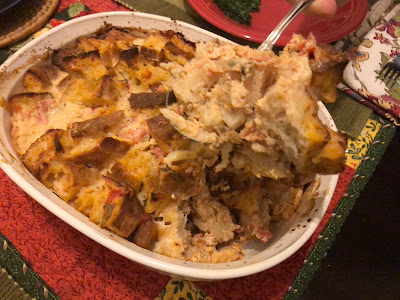
Recipe: Tomatoes add color to savory bread pudding

The skins slip right off after garlic cloves are boiled in broth, which mellows the garlic's bite. (Photos: Kathy Morrison)
|
A gardener's dilemma is often solved in the kitchen.
The most recent problem I encountered was what to do with the many small cloves left over from planting my garlic. Gardeners are advised to plant only the biggest cloves, and to keep the skin on them to protect the cloves while they're growing.
But when I broke up the heads from my seed garlic (late California variety), there were so many small cloves! I did have enough big ones to plant, but I was going to have to cook the little ones soon or risk them drying out. (For the record, you also can plant the small cloves to grow garlic scapes.)
I decided to unearth a cooking trick I learned years ago: Boiling the garlic cloves in broth or water. The boiling mellows the garlic's pungency. The boiled garlic is solid, not buttery, as when whole heads are roasted.
Some home-canned yellow tomatoes, some red ones from the freezer and half a loaf of stale ciabatta bread became the rest of the base for a garlic-infused bread pudding that is a terrific casserole or side dish for a fall dinner.

|
Tomato-garlic bread pudding
Serves 6
Ingredients:
1 to 2 cups chicken or vegetable broth
20 or so smallish garlic cloves, separated from the head
6 eggs, room temperature
1 cup milk or half and half
4 cups (2 pints) peeled tomatoes, with juice if canned, cut into chunks if they're whole
Salt and pepper
Seasonings: 1 tablespoon no-salt Italian seasoning, 1 tablespoon chopped parsley (or 1 teaspoon dried),
and handful of fresh basil leaves (sliced or chopped), or any variation of this as desired
8 cups of cubes from stale bread
Grated Parmesan cheese, for sprinkling
Instructions:
Heat oven to 375 degrees F. Grease a 2-1/2 quart baking dish with oil spray or butter.
Pour the broth into a small saucepan and bring to a boil. Trim the small stem end from the garlic cloves, then add the cloves to the boiling broth. Simmer on medium heat for 10 minutes or until the tip of a knife easily goes into one of the larger cloves. Don't dump the broth when straining: Lift the cloves out with a slotted spoon and put them on a cutting board.
Slip the skins off the cloves (they may be off already) and set aside for now. (The larger cloves can be cut in half if desired.)
In a large bowl, whisk together the eggs and milk. Add the tomatoes, salt and pepper to taste, the seasonings, and the garlic cloves. Add the bread cubes and stir thoroughly. At this point you can let the cubes soak up the liquid for a bit, if the bread is very stale, or continue to baking.
If the mixture still seems a bit dry to you, add some of the broth reserved from boiling the garlic.

|
When ready to bake, pour the bread mixture into the prepared pan.
Bake uncovered for 20 minutes. Sprinkle the Parmesan over the top, and cover the dish with the lid or a large piece of foil that has been sprayed with oil on one side (to keep the cheese from sticking to the foil).
Bake covered for an additional 20 minutes. Check for doneness — the liquid should be mostly absorbed and the pudding will be puffy. Add more cheese if desired. Bake for 5 to 10 minutes more uncovered. The pudding will be bubbling on the edges and the top will be golden and crispy. A knife inserted in center should come out clean.
Serve pudding warm or room temperature. Leftovers reheat well.
Comments
0 comments have been posted.Sacramento Digs Gardening to your inbox.
Sites We Like
Garden Checklist for week of May 12
Get your gardening chores and irrigation done early in the day before temperatures rise.
* Plant, plant, plant! It’s prime planting season in the Sacramento area. Time to set out those tomato transplants along with peppers and eggplants. Pinch off any flowers on new transplants to make them concentrate on establishing roots instead of setting premature fruit.
* Direct-seed melons, cucumbers, summer squash, corn, radishes, pumpkins and annual herbs such as basil.
* Harvest cabbage, lettuce, peas and green onions. This heat will cause leafy greens and onions to flower; pick them before they bolt.
* In the flower garden, direct-seed sunflowers, cosmos, salvia, zinnias, marigolds, celosia and asters.
* Plant dahlia tubers. Other perennials to set out include verbena, coreopsis, coneflower and astilbe.
* Transplant petunias, marigolds and perennial flowers such as astilbe, columbine, coneflowers, coreopsis, dahlias, rudbeckia and verbena.
* Keep an eye out for slugs, snails, earwigs and aphids that want to dine on tender new growth.
* Feed summer bloomers with a balanced fertilizer.
* For continued bloom, cut off spent flowers on roses as well as other flowering plants.
* Got fruit trees? If you haven't already done so, thin orchard fruit such as apples, peaches, pears, pluots and plums before they grow too heavy, breaking branches or even splitting the tree. Leave the largest fruit on the branch, culling the smaller ones, and allow for 5 to 6 inches (or a hand's worth) between each fruit.
* Thin grape bunches, again leaving about 6 inches between them. For the remaining bunches, prune off the "tail" end, about the bottom third of the bunch, so that the plant's energy is concentrated in the fruit closest to the branch.
* As spring-flowering shrubs finish blooming, give them a little pruning to shape them, removing old and dead wood. Lightly trim azaleas, fuchsias and marguerites for bushier plants.
* Add mulch to the garden to help keep that precious water from evaporating. Mulch also cuts down on weeds. But don’t let it mound around the stems or trunks of trees or shrubs. Leave about a 6-inch to 1-foot circle to avoid crown rot or other problems.